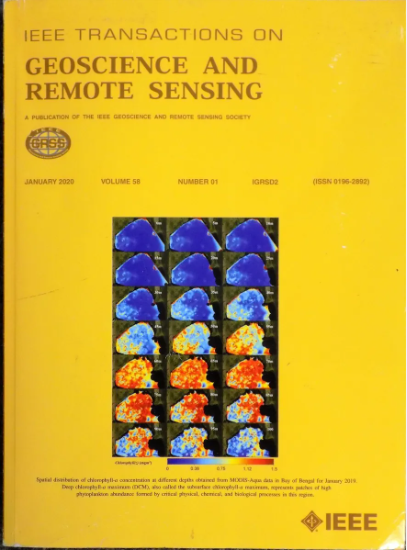基于多源数据和Transformer深度学习模型的叶面积指数高分辨率无缝映射
IF 7.5
1区 地球科学
Q1 ENGINEERING, ELECTRICAL & ELECTRONIC
IEEE Transactions on Geoscience and Remote Sensing
Pub Date : 2025-04-16
DOI:10.1109/TGRS.2025.3561326
引用次数: 0
摘要
叶面积指数(LAI)是监测植被健康和研究气候变化的重要参数。大部分LAI产品的空间分辨率在500 ~ 1000m之间。只有少数LAI产品的空间分辨率在16 - 30 m之间,但由于卫星的重访周期和天气条件的影响,出现了明显的数据缺失。这些方法不能满足LAI应用社区的需求。为了解决这一问题,提出了一种基于多源数据和Transformer深度学习模型的LAI高分辨率无缝映射工作流。选取中国江苏省作为研究区域。在这个地区,每年都有许多阴雨天。得到了Landsat和Sentinel-2 (HLS)和中分辨率成像光谱辐射计(MODIS)的统一反射率图像。首先对MODIS和HLS图像进行合成和空间对齐。然后,在MODIS影像的基础上,结合光谱自动校正(FIRST)方法进行时空融合,重构缺失的HLS影像数据,得到空间分辨率为30 m、时间分辨率为12天的反射率产品。在反射率积的基础上,设计了用于LAI预测的Transformer模型,并与反向传播神经网络(BPNN)、卷积神经网络(CNN)、长短期记忆(LSTM)和双向LSTM (Bi-LSTM)方法设计的模型进行了比较。在独立数据集的基础上,对这些模型进行了迁移学习和不迁移学习的比较。选取最优模型生成研究区LAI产品,并与已有MODIS产品从时空角度进行比较。结果表明,HLS重建方法是有效的,不同波段的误差在4.00% ~ 15.93%之间。在LAI预测模型中,Transformer模型在所有场景中始终表现最好。值得注意的是,通过迁移学习训练的Transformer模型产生了最好的结果,其测试值R^{2}$为0.62,均方根误差(RMSE)为0.79,平均相对误差(MRE)为14.80%。其他模型的$R^{2}$取值范围为0.31 ~ 0.59,RMSE取值范围为0.82 ~ 1.06,MRE取值范围为15.41% ~ 22.28%。此外,利用上述最佳模型建立的HLS LAI比MODIS LAI产品具有更高的时空精度。本研究为构建高时空分辨率的无缝LAI产品提供了参考数据,有助于植被健康监测和全球变化研究等应用。本文章由计算机程序翻译,如有差异,请以英文原文为准。
High-Resolution Seamless Mapping of the Leaf Area Index via Multisource Data and the Transformer Deep Learning Model
The leaf area index (LAI) is a critical parameter for monitoring vegetation health and studying climate change. The spatial resolutions of most LAI products range from 500 to 1000 m. Only a few LAI products exhibit spatial resolutions ranging from 16 to 30 m, but notable missing data occur because of the revisit cycle of satellites and the effect of weather conditions. These methods cannot satisfy the requirements of LAI application communities. To address this issue, a workflow was proposed for high-resolution seamless mapping of the LAI on the basis of multisource data and the Transformer deep learning model. Jiangsu Province in China was chosen as the study area. In this area, numerous cloudy and rainy days occur annually. Harmonized Landsat and Sentinel-2 (HLS) and moderate resolution imaging spectroradiometer (MODIS) reflectance images were obtained. The MODIS and HLS images were first composited and spatially aligned. Then, on the basis of the MODIS images and the spatiotemporal fusion incorporating spectral autocorrection (FIRST) method, missing HLS image data were reconstructed, thus producing a reflectance product with a spatial resolution of 30 m and a temporal resolution of 12 days. On the basis of the reflectance product, a Transformer model was designed for LAI prediction and compared with models designed through backpropagation neural network (BPNN), convolutional neural network (CNN), long short-term memory (LSTM), and bidirectional LSTM (Bi-LSTM) methods. These models were compared with and without transfer learning on the basis of an independent dataset. The best model was selected and employed to produce a LAI product for the study area, which was subsequently compared with an existing MODIS product from spatial and temporal perspectives. The results showed that the procedure for HLS reconstruction is effective, with errors varying between 4.00% and 15.93% for different bands. Among the LAI prediction models, the Transformer model consistently performed the best across all scenarios. Notably, the Transformer model trained via transfer learning yielded the best results, with a test $R^{2}$ value of 0.62, a root mean square error (RMSE) of 0.79 and a mean relative error (MRE) of 14.80%. The $R^{2}$ values of the other models ranged from 0.31 to 0.59, the RMSE values ranged from 0.82 to 1.06, and the MRE values ranged from 15.41% to 22.28%. In addition, the HLS LAI established via the above best model provided greater spatiotemporal accuracy than did the MODIS LAI product. This study provides reference data for establishing seamless LAI products with high spatial and temporal resolutions, contributing to applications such as vegetation health monitoring and global change research.
求助全文
通过发布文献求助,成功后即可免费获取论文全文。
去求助
来源期刊

IEEE Transactions on Geoscience and Remote Sensing
工程技术-地球化学与地球物理
CiteScore
11.50
自引率
28.00%
发文量
1912
审稿时长
4.0 months
期刊介绍:
IEEE Transactions on Geoscience and Remote Sensing (TGRS) is a monthly publication that focuses on the theory, concepts, and techniques of science and engineering as applied to sensing the land, oceans, atmosphere, and space; and the processing, interpretation, and dissemination of this information.
 求助内容:
求助内容: 应助结果提醒方式:
应助结果提醒方式:


